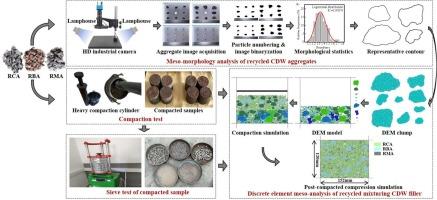建筑和爆破垃圾混合集料在压实和双轴压缩过程中的颗粒破碎行为
IF 4.6
2区 工程技术
Q2 ENGINEERING, CHEMICAL
引用次数: 0
摘要
建筑垃圾材料的破坏行为对路面基层的力学性能有重要影响。本文采用DEM模型对再生CDW基层填料的压实和双轴压缩进行了数值模拟。该模型通过压实和筛分试验以及形貌分析进行参数化,明确考虑颗粒形状、级配和混合比例。结合实验和数值结果,系统揭示了压实和压实后双轴压缩过程中的细观破坏机制及其演化。结果表明,再生混凝土骨料(RCA)、再生砖骨料(RBA)和再生砂浆骨料(RMA)的掺量比以及RCA和RBA的粒度分布是决定混合料破碎性能的主要因素。RBA和RMA是断裂的主要来源。较小的RBA颗粒更容易被粉碎,这增加了粘结破坏比,但降低了体积破坏比。较高的RBA含量和较小的RBA尺寸进一步加速了压实后双轴压缩过程中的粘结断裂。RCA作为骨架,形成主力链,RBA和RMA形成辅助链,帮助RCA重新分布和减轻断裂。优化RCA比例和RBA尺寸可提高致密性和稳定性。当RCA: RBA: RMA的混合比为6:3:1,RBA粒径小于9.5 mm时,可获得最大干密度和最佳力学性能。研究结果为再生CDW路面基层填料的配合比优化及工程应用提供了理论和实践支持。本文章由计算机程序翻译,如有差异,请以英文原文为准。

Particle breakage behavior of recycled construction and demolition waste mixed aggregates during compaction and biaxial compression
The breakage behavior of construction and demolition waste (CDW) materials significantly impacts the mechanical performance of pavement base courses. In this study, a DEM model was employed to simulate the compaction and biaxial compression of recycled CDW base-course filler. The model was parameterized using compaction and sieving tests and morphology analysis, explicitly accounting for particle shape, gradation, and mix proportion. By integrating laboratory and numerical results, the mesoscopic breakage mechanisms and their evolution during compaction and post-compaction biaxial compression were systematically revealed. Results show that the mixing ratios of recycled concrete aggregate (RCA), recycled brick aggregate (RBA), and recycled mortar aggregate (RMA), as well as the particle size distributions of RCA and RBA, primarily determine the crushing behavior of the mixture. RBA and RMA are the main sources of breakage. Smaller RBA particles are more susceptible to pulverization, which increases the bond breakage ratio but reduces the volumetric breakage ratio. Higher RBA content and smaller RBA size further accelerate bond breakage during post-compaction biaxial compression. RCA serves as the skeleton, forming main force chains, while RBA and RMA form secondary chains that help redistribute and alleviate breakage of RCA. Optimizing RCA proportion and RBA size improves compactness and stability. When the mix ratio of RCA: RBA: RMA is 6:3:1 and RBA particle size is less than 9.5 mm, maximum dry density and optimal mechanical performance are achieved. These findings provide theoretical and practical support for mix ratio optimization and engineering application of recycled CDW pavement base fillers.
求助全文
通过发布文献求助,成功后即可免费获取论文全文。
去求助
来源期刊

Powder Technology
工程技术-工程:化工
CiteScore
9.90
自引率
15.40%
发文量
1047
审稿时长
46 days
期刊介绍:
Powder Technology is an International Journal on the Science and Technology of Wet and Dry Particulate Systems. Powder Technology publishes papers on all aspects of the formation of particles and their characterisation and on the study of systems containing particulate solids. No limitation is imposed on the size of the particles, which may range from nanometre scale, as in pigments or aerosols, to that of mined or quarried materials. The following list of topics is not intended to be comprehensive, but rather to indicate typical subjects which fall within the scope of the journal's interests:
Formation and synthesis of particles by precipitation and other methods.
Modification of particles by agglomeration, coating, comminution and attrition.
Characterisation of the size, shape, surface area, pore structure and strength of particles and agglomerates (including the origins and effects of inter particle forces).
Packing, failure, flow and permeability of assemblies of particles.
Particle-particle interactions and suspension rheology.
Handling and processing operations such as slurry flow, fluidization, pneumatic conveying.
Interactions between particles and their environment, including delivery of particulate products to the body.
Applications of particle technology in production of pharmaceuticals, chemicals, foods, pigments, structural, and functional materials and in environmental and energy related matters.
For materials-oriented contributions we are looking for articles revealing the effect of particle/powder characteristics (size, morphology and composition, in that order) on material performance or functionality and, ideally, comparison to any industrial standard.
 求助内容:
求助内容: 应助结果提醒方式:
应助结果提醒方式:


